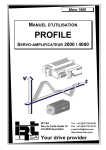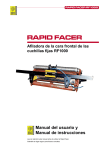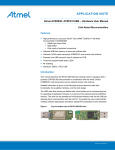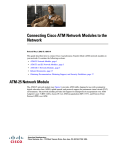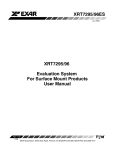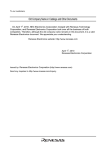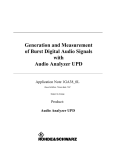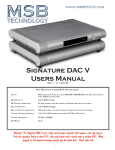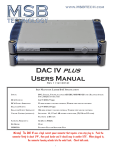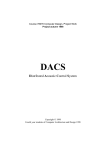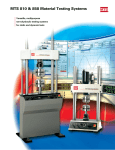Download Evaluation System User Manual
Transcript
...the analog plus company TM XR-T6164-65-66ES December 1996-2 XR-T6164/T6165/T6166 Evaluation System User Manual Rev. 2.00 1996 EXAR Corporation, 48720 Kato Road, Fremont, CA 94538 (510) 668-7000 FAX (510) 668-7017 XR-T6164-65-66ES NOTICE EXAR Corporation reserves the right to make changes to the products contained in this publication in order to improve design, performance or reliability. EXAR Corporation assumes no responsibility for the use of any circuits described herein, conveys no license under any patent or other right, and makes no representation that the circuits are free of patent infringement. Charts and schedules contained herein are only for illustration purposes and may vary depending upon a user’s specific application. While the information in this publication has been carefully checked; no responsibility, however, is assumed for inaccuracies. EXAR Corporation does not recommend the use of any of its products in life support applications where the failure or malfunction of the product can reasonably be expected to cause failure of the life support system or to significantly affect its safety or effectiveness. Products are not authorized for use in such applications unless EXAR Corporation receives, in writing, assurances to its satisfaction that: (a) the risk of injury or damage has been minimized; (b) the user assumes all such risks; (c) potential liability of EXAR Corporation is adequately protected under the circumstances. Copyright 1996 EXAR Corporation User Manual December 1996 Reproduction, in part or whole, without the prior written consent of EXAR Corporation is prohibited. Rev. 2.00 2 Table of Contents OVERVIEW . . . . . . . . . . . . . . . . . . . . . . . . . . . . . . . . . . . . . . . . . . . . . . . . . . . . . . . . . . . . 5 MECHANICAL DESCRIPTION . . . . . . . . . . . . . . . . . . . . . . . . . . . . . . . . . . . . . . . . . . . Figure 1. Mother Board Component Marking . . . . . . . . . . . . . . . . . . . . . Figure 2. XR-T6165 Daughter Board Component Marking . . . . . . . . Figure 3. XR-T6166 Daughter Board Component Marking . . . . . . . . Figure 4. XR-T6164 LIU Daughter Board Component Marking . . . . . 5 6 7 7 7 ELECTRICAL DESCRIPTION . . . . . . . . . . . . . . . . . . . . . . . . . . . . . . . . . . . . . . . . . . . . Block-level Overview . . . . . . . . . . . . . . . . . . . . . . . . . . . . . . . . . . . . . . . . . . . . . . . Timing Generation Logic . . . . . . . . . . . . . . . . . . . . . . . . . . . . . . . . . . . . . . . . . . Pattern Generator . . . . . . . . . . . . . . . . . . . . . . . . . . . . . . . . . . . . . . . . . . . . . . . . XR-T6165/6166 Time Slot Selection and Alarm Control . . . . . . . . . . . . . . . Demo Board Power Requirements . . . . . . . . . . . . . . . . . . . . . . . . . . . . . . . . . . . Input/Output Connections . . . . . . . . . . . . . . . . . . . . . . . . . . . . . . . . . . . . . . . . . . 64 KBT/Sec Signal Connections . . . . . . . . . . . . . . . . . . . . . . . . . . . . . . . . . . . BNC Connections . . . . . . . . . . . . . . . . . . . . . . . . . . . . . . . . . . . . . . . . . . . . . . . . Test Points . . . . . . . . . . . . . . . . . . . . . . . . . . . . . . . . . . . . . . . . . . . . . . . . . . . . . . Figure 5. Demo Board Block Diagram . . . . . . . . . . . . . . . . . . . . . . . . . . . Table 1. DIP Switch S3 Functions . . . . . . . . . . . . . . . . . . . . . . . . . . . . . . Table 2. Dip Switch S4 Functions . . . . . . . . . . . . . . . . . . . . . . . . . . . . . . Table 3. TXTS1 and RXTS1 Selection Options . . . . . . . . . . . . . . . . . . . Table 4. Dip Switch S2 Functions . . . . . . . . . . . . . . . . . . . . . . . . . . . . . . . Table 5. Pattern Generator Bit Patterns . . . . . . . . . . . . . . . . . . . . . . . . . Table 6. Dip Switch S1 Functions . . . . . . . . . . . . . . . . . . . . . . . . . . . . . . . Table 7. BNC Connector Functions . . . . . . . . . . . . . . . . . . . . . . . . . . . . . Table 8. Test Point Functions . . . . . . . . . . . . . . . . . . . . . . . . . . . . . . . . . . 8 8 8 8 9 9 9 9 9 9 10 11 11 12 13 13 13 14 14 BOARD OPERATION . . . . . . . . . . . . . . . . . . . . . . . . . . . . . . . . . . . . . . . . . . . . . . . . . . . Start-up Procedure . . . . . . . . . . . . . . . . . . . . . . . . . . . . . . . . . . . . . . . . . . . . . . . . . Waveform Measurements . . . . . . . . . . . . . . . . . . . . . . . . . . . . . . . . . . . . . . . . . . . Operation With A Repetitive 4-Word Sequence . . . . . . . . . . . . . . . . . . . . . . . Advanced Capabilities . . . . . . . . . . . . . . . . . . . . . . . . . . . . . . . . . . . . . . . . . . . . . . Receive Buffer Tests . . . . . . . . . . . . . . . . . . . . . . . . . . . . . . . . . . . . . . . . . . . . . Transmit Buffer Tests . . . . . . . . . . . . . . . . . . . . . . . . . . . . . . . . . . . . . . . . . . . . . Timing Alignment Tests . . . . . . . . . . . . . . . . . . . . . . . . . . . . . . . . . . . . . . . . . . . Table 9. Dip Switch Preset Positions . . . . . . . . . . . . . . . . . . . . . . . . . . . Figure 6. XR-T6166 Transmitter-side Waveforms . . . . . . . . . . . . . . . . . Figure 7. XR-T6166 Receiver-side Waveforms . . . . . . . . . . . . . . . . . . . Figure 8. XR-T6166 Transmitter Output Waveforms . . . . . . . . . . . . . . . Figure 9. Timing with Repetitive Word 0 . . . . . . . . . . . . . . . . . . . . . . . . . Figure 10. Frame 1 - Timing with 4-Word Sequence . . . . . . . . . . . . . . Figure 11. Frame 2 - Timing with 4-Word Sequence . . . . . . . . . . . . . . . Figure 12. Frame 3 - Timing with 4-Word Sequence . . . . . . . . . . . . . . Figure 13. Frame 4 - Timing with 4-Word Sequence . . . . . . . . . . . . . . Figure 14. Frame 5 - Timing with 4-Word Sequence . . . . . . . . . . . . . . 14 14 14 15 15 15 16 16 17 18 18 18 19 19 20 20 21 21 Rev. 2.00 3 Table of Contents (Continued) SCHEMATIC DIAGRAMS . . . . . . . . . . . . . . . . . . . . . . . . . . . . . . . . . . . . . . . . . . . . . . . . 22 LIST OF MATERIALS . . . . . . . . . . . . . . . . . . . . . . . . . . . . . . . . . . . . . . . . . . . . . . . . . . . Figure 15. Demo Board Top Level Schematic . . . . . . . . . . . . . . . . . . . . Figure 16. Demo Board Option Selection Switch Schematic . . . . . . . . Figure 17. Demo Board Option Input/Output Connector Schematic . Figure 18. Demo Board Timing Logic Schematic . . . . . . . . . . . . . . . . . Figure 19. XR-T6165 and XR-T6166 Daughter Board Schematic . . . Figure 20. XR-T6164 LIU Daughter Board Schematic . . . . . . . . . . . . . Table 10. XR-T6164/65/66 Mother Demo Board Parts List . . . . . . . . . Table 11. XR-T6164 LIU Daughter Board Parts List . . . . . . . . . . . . . . Table 12. XR-T6165 Daughter Board Parts List . . . . . . . . . . . . . . . . . . Table 13. XR-T6166 Daughter Board Parts List . . . . . . . . . . . . . . . . . 22 23 24 25 26 27 27 28 29 29 29 Rev. 2.00 4 XR-T6164ES ...the analog plus company TM Evaluation System OVERVIEW MECHANICAL DESCRIPTION This demo board is an evaluation system for the XR-T6164 LIU (Line Interface Unit) and XR-T6165/6166 Codirectional Digital Data Processor integrated circuits that simplifies both functional tests and comprehensive measurements on these devices. Test equipment requirements are minimized because a built-in pattern generator supplies PCM test data, and all timing signals are derived from an on-board crystal oscillator. Board operation requires only a 5V power source and an oscilloscope for observing data and timing waveforms. Figure 1 shows the mother board component marking. Option selection dip switches are located along the front edge. Directly behind them are five PALS that generate timing signals, an 8.192MHz crystal oscillator module that provides system clock, and a 74HC00 device that de-bounces the RESET switch, and buffers PCM frame sync outputs. Daughter boards for the XR-T6165 or XR-T6166 IC socket and for the XR-T6164 LIU are behind the PALS. Figure 2, Figure 3, and Figure 4 show daughter board component markings. BNC connectors that are located along the mother board right edge are used for sync and timing signal outputs, and for external clock inputs. Two RJ-11 and a spare RJ-45 modular connector for 64 KBT/S I/O connections, and test points for XR-T6165/6166 output signals are located on the board rear edge. The test point signals are also present at small pads that are under the daughter boards. Therefore, any two of these signals may be easily connected with short jumper wires to the spare BNC connectors that are between the daughter boards. Power connections are made through two banana jacks that are located on the board left edge. Mechanically, the unit is a 5.75 by 7.75 inch mother board that accepts a pair of 2 inch by 2 inch daughter boards. The mother board contains timing logic, option selection switches, and I/O connections. One daughter board has the socket for either the XR-T6165 or the XR-T6166 device while the other holds the complete XR-T6164 LIU circuit. Programmable logic devices (PALS) are used for all mother board logic to make the unit electrically as well as mechanically versatile. Rev. 2.00 5 XR-T6164-65-66ES Figure 1. Mother Board Component Marking Rev. 2.00 6 XR-T6164-65-66ES Figure 2. XR-T6165 Daughter Board Component Marking Figure 3. XR-T6166 Daughter Board Component Marking Figure 4. XR-T6164 LIU Daughter Board Component Marking Rev. 2.00 7 XR-T6164-65-66ES time slot edge is not required. Therefore, these signals arrive one 8.192MHz clock period before the retimed signals. ELECTRICAL DESCRIPTION This description refers to Figure 5 and Table 1 through Table 8 that are located at the end of this section. Although the following discussion explicitly mentions the XR-T6166, the general information given applies equally well to the XR-T6165. Note that this device does not have the RXCKOUT, CS, BIR, BDR, BIT and BDT outputs that are present on the XR-T6166. Consult the device data sheets for more detailed information on each part. The transmit counter is always clocked by the on-board 8.192MHz crystal oscillator module. However, the receive counter may be clocked either by this oscillator, or by an external 8.192MHz source. The 2 input to 1 output receive clock multiplexer that is controlled by S4, section 1, does this selection. Receive counter reset is performed through the 2 input to 1 output reset multiplexer. When the on-board oscillator is used to clock both counters, the receive counter is synchronously reset every four PCM frames by the transmit counter CLROUT pulse. Thus, synchronization is automatically obtained between the two counters. When an external receive clock source is used, the push button reset switch, S5, will initially synchronize the transmit and receive counters. S5 is non-functional when the on-board oscillator clocks both counters. Block-level Overview The block diagram given in Figure 5 outlines the major demo board functions. It illustrates data and timing signal flow, and shows option selection switch connections to the different functional blocks. The top part of the diagram contains the transmit and the bottom part has the receive sides of the XR-T6166 digital processor and XR-T6164 LIU. Signal flow is clockwise starting with the pattern generator. The pattern generator supplies 8 bit bursts of 2.048MBT/Sec serial PCM data to the XR-T6166 transmitter PCMIN input. The XR-T6166 transmitter T+R and T-R outputs feed continuous, dual-rail, 64 KBT/Sec encoded data into the XR-T6164 LIU. The bipolar signal produced by the LIU transmitter is connected to the LIU receiver input by a short modular cable. The LIU receiver output dual-rail data is connected to the XR-T6166 receiver S+R and S-R inputs. The XR-T6166 receiver PCMOUT output provides 8 bit bursts of 2.048 MBT/Sec PCM data. The signal at this test point may be observed on an oscilloscope. Any of the 32 possible transmit and receive time slot positions are user-selectable by binary coded settings on S3 and S4 respectively. S3 also selects pattern generator sequence length and XR-6166 transmitter 256kHz clock source. S4 also selects receive timing logic 8.192MHz clock source. Table 1 and Table 2 summarize S3 and S4 functions respectively. Table 3 lists the binary settings for S3 and S4 for all 32 time slots. Pattern Generator The pattern generator produces 8-bit bursts of data at a 2.048 MBT/Sec rate. This data, which may be either a repetitive one-word (8 bit) or four-word (32 bit) sequence, simulates the information that is taken from a PCM system buss and applied to the XR-6166 transmit side serial input (PCMIN). The pattern generator produces one user-programmable word (WORD 0) followed by three fixed words that are determined by PAL programming. It operates by decoding transmit timing logic counter outputs, anding this signal with the decoded signal that becomes the transmit time slot, and then retiming the result with the 8.192MHz clock and a D-type flip flop. The option of sending either WORD 0 repetitively, or the entire four-word sequence repetitively is available. Table 4 shows WORD 0 programming by S2, and Table 5 lists the bit patterns for all four words. The distinctive patterns with a single “one” bit were chosen for words 1, 2, and 3 because they make it easy to observe the delay through the looped-back system on an Timing Generation Logic The timing generation logic uses synchronous counters clocked at 8.192MHz rate to produce all the control signals necessary for XR-T6166 operation. Separate counters are used for generating the transmit and receive timing signals for maximum versatility. The transmit and receive time slot signals (TS1T and TS1R) are obtained by decoding the respective counter outputs, and then using the 8.192MHz clock and a D-type flip flop to re-time the signal. Thus, these outputs are glitch-free. The transmit and receive clocks (TX2MHZ and RX2MHZ) come from a single counter output and are retimed to preserve alignment with the time slot edges. The 256kHz transmit clock (TX256kHz), transmit frame sync (TSYNC OUT), receive frame sync (RSYNC OUT) and pattern generator WORD SYNC also come from single counter outputs, but are not retimed because alignment with a Rev. 2.00 8 XR-T6164-65-66ES oscilloscope. This procedure is explained in more detail in the section on board operation. at the rear of the board. The short jumper cable supplied with the board is used to connect the transmitter output to the receiver input during testing. This jumper does not contain a “twist” like a modular telephone cord. A standard modular cord will give a tip-ring reversal between transmitter output and receiver input. XR-T6165/6166 Time Slot Selection and Alarm Control The XR-T6165/6166 contains internal 2 input to 1 output multiplexers that select one of two available transmit and receive time slot sources. Both transmit and receive time slot 1 are generated on-board while time slot 2 is obtained from an external source. Also, three transmit and receive alarms options are available. Table 6 summarizes the functions controlled by S1. An unconnected RJ-45 jack that may be used for both input and output functions is also provided. This jack may be easily connected as required since all eight pins are brought out to PC board pads. BNC Connections Demo Board Power Requirements Inputs for external clocks and timing signals as well as transmit and receive sync outputs are made through BNC connectors. Two extra connectors are provided for use as needed. Table 7 lists the connector functions. A well-regulated +5.0V 5%V source of at least 1 Ampere is necessary for board operation. Power connections are made through red (+5) and black (Ground) banana jacks. Test Points Input/Output Connections Test points provide access to a number of different XR-T6166 output signals and circuit ground. Their functions are listed in Table 8. For convenience, the test point signals are also connected to small PC board pads that are located under the XR-T6166 daughter board. 64 KBT/Sec Signal Connections The LIU transmitter output and receiver input 64 KBT/S signal connections are made through RJ-11 jacks located Rev. 2.00 9 XR-T6164-65-66ES BLOCK DIAGRAM Figure 5. Demo Board Block Diagram Rev. 2.00 10 XR-T6164-65-66ES Section Number and Name 1 WORDS - 1/4 2 T256 - EXT/INT Function Switch Setting Option Selects Repetitive 1 or 4 Word Sequence OFF Repeats 8-Bit PCMIN Word 1 (Pattern Set By S2) ON Repeats 32 Bit Sequence Composed of PCMIN Word 1 Followed By 3 Built-in Words OFF External Transmit Clock Applied to T256kHz IN Input Used ON Clock Generated Internally By Demo Board Used OFF Bit is a Logic 1 ON Bit is a Logic 0 Selects 256kHz Transmit Clock Source 3 Through g 7 TXTS1 PGM Selects Transmit Time Slot 1 Position d iis (5 Bit Bi Binary C Code Time Slot Number) 8 (Section Not Used) Table 1. DIP Switch S3 Functions Section Number and Name 1 RXCLK - EXT/INT Function Switch Setting Option Selects 8.192MHz Receive Clock Source OFF External Clock Applied to R8MHZ IN Input Used ON Clock Generated Internally By Demo Board Used OFF Bit is a Logic 1 ON Bit is a Logic 0 2 (Section Not Used) 3 Through g 7 RXTS1 PGM Selects Receive Time Slot 1 Position d iis (5 Bit Bi Binary C Code Time Slot Number) 8 (Section Not Used) Table 2. Dip Switch S4 Functions Rev. 2.00 11 XR-T6164-65-66ES Time Slot Position Dip Switch Setting (S3 and S4) SEL0 SEL1 SEL2 SEL3 SEL4 0 ON ON ON ON ON 1 OFF ON ON ON ON 2 ON OFF ON ON ON 3 OFF OFF ON ON ON 4 ON ON OFF ON ON 5 OFF ON OFF ON ON 6 ON OFF OFF ON ON 7 OFF OFF OFF ON ON 8 ON ON ON OFF ON 9 OFF ON ON OFF ON 10 ON OFF ON OFF ON 11 OFF OFF ON OFF ON 12 ON ON OFF OFF ON 13 OFF ON OFF OFF ON 14 ON OFF OFF OFF ON 15 OFF OFF OFF OFF ON 16 ON ON ON ON OFF 17 OFF ON ON ON OFF 18 ON OFF ON ON OFF 19 OFF OFF ON ON OFF 20 ON ON OFF ON OFF 21 OFF ON OFF ON OFF 22 ON OFF OFF ON OFF 23 OFF OFF OFF ON OFF 24 ON ON ON OFF OFF 25 OFF ON ON OFF OFF 26 ON OFF ON OFF OFF 27 OFF OFF ON OFF OFF 28 ON ON OFF OFF OFF 29 OFF ON OFF OFF OFF 30 ON OFF OFF OFF OFF 31 OFF OFF OFF OFF OFF Table 3. TXTS1 and RXTS1 Selection Options Rev. 2.00 12 XR-T6164-65-66ES Section Number and Name Function Switch Setting Option 1 through 8 PCMIN WORD 0 BIT PGM Programs 8 bit PCMIN Word 1 OFF Sets Bit in PCMIN Word 1 (Transmitter Input Data) to a High Level (Logic 1) ON Sets Bit in PCMIN Word 1 (Transmitter Input Data) to a Low Level (Logic 0) Table 4. Dip Switch S2 Functions Word Bit Pattern Notes 0 10101001 User-Programmable with S2 1 00000001 Programmed in PAL 2 10000000 Programmed in PAL 3 00010000 Programmed in PAL Table 5. Pattern Generator Bit Patterns Section Number and Name 1 Blanking - AIS/OFF 2 BLS - OFF/ON 3 TXTS - 1/2 4 ALARMIN - ON/OFF 5 RXTS - 1/2 6, 7, 8 Function Switch Setting Option Controls PCMOUT Data Blanking OFF Receiver Data at PCMOUT Always Forced to all Ones Condition (AIS Signal) ON Normal Receiver Output Data Present at PCMOUT Controls Byte Lock Supervision OFF BLS (Byte Lock Supervision) Not Active, Data at PCMOUT is Always Receiver Input Data (Sets T6166 Pin 4 Logic Level) ON BLS (Byte Lock Supervision) Active, PCMOUT Blanked When AIS Received Selects Transmit Time Slot OFF Transmit Time Slot 1 (Internally Generated on Demo Board) Used (Sets T6166 Pin 15 Logic Level) ON Transmit Time Slot 2 (Externally Applied to TTS2 IN Input) Used Provides Alarm Input Signal OFF Violations Used for Octet Timing in Transmitter Output Signal are Inhibited (Alarm Condition) (Sets T6166 Pin 16 Logic Level) ON Violations Used for Octet Timing are Present in Transmitter Output Signal (Normal Operation) Selects Receive Time Slot OFF Receive Time Slot 1 (Internally Generated On Demo Board) Used (Sets T6166 Pin 27 Logic Level) ON Receive Time Slot 2 (Applied To RTS2 In Input) Used (Sets T6166 Pin 6 Logic Level) (Section Not Used) Table 6. Dip Switch S1 Functions Rev. 2.00 13 XR-T6164-65-66ES BNC Conn. Signal Description TTS2 IN Transmit Time Slot 2 Input (Connected to T6166 Pin 12) RTS2 IN Receive Time Slot 2 Input (Connected to T6166 Pin 24) RSYNC OUT Buffered 8kHz Receive Frame Sync Signal Output TSYNC OUT Buffered 8kHz Transmit Frame Sync Signal Output R8MHZ IN External 8.192MHz Receive Timing Logic Clock Input T256kHz IN External 256kHz Transmit Clock Input (Connected to T6166 Pin 17) SPARE Uncommitted Connector SPARE Uncommitted Connector Table 7. BNC Connector Functions Test Point Signal Description RXALM LIU Loss of Signal Alarm Output (T6164 Pin 3) GND Circuit Ground ALARM Octet Timing Alarm Output (T6166 Pin 1) RXCKOUT Extracted 128kHz Receive Clock Output (T6166 Pin 7) BDT Transmitter Byte Deletion Flag Output (T6166 Pin 11) BIT Transmitter Byte Insertion Flag Output (T6166 Pin 18) CS Clock Seek Output from Receiver Clock Recovery Circuit (T6166 Pin 22) BDR Receiver Byte Deletion Flag Output (T6166 Pin 25) BIR Receiver Byte Insertion Flag Output (T6166 Pin 26) PCMOUT Receiver PCM Data Output (T6166 Pin 28) GND Circuit Ground WORD SYNC 2kHz Sync Signal Output for Pattern Generator 4-Word Sequence Table 8. Test Point Functions This description refers to Table 9 and Figure 6 through Figure 14 which are located at the end of this section. 3. Power the board by connecting a regulated power supply capable of supplying 5V $5% at least 1 Ampere to the red (+5V) and black (Ground) banana jacks. Start-up Procedure Waveform Measurements Perform the following steps to operate the demo board. The board is now in operation, and Figure 6, Figure 7, and Figure 8 are examples of some of the waveforms that may be observed. Figure 6 shows the acquisition of a byte of 2.048MBT/Sec data by XR-T6166 transmit-side. While the transmit time slot (TS1T) is high, the 2.048MHz transmit clock (TX2MHZ) clocks the 8-bit pattern 1 0 1 0 1 0 0 1 into the serial data input (PCMIN). The clock, data, and time slot edges are all aligned since these signals, BOARD OPERATION 1. Preset the four dip switches indicated in Table 9. in the positions 2. Connect TX OUT to RX IN RJ-11 connectors together with the short modular cable supplied with the board. This operation loops the XR-T6164 LIU transmitter line-side output to receiver line-side input. Rev. 2.00 14 XR-T6164-65-66ES loopedback system. However, this delay can be measured by using a repetitive 4-word sequence. which are derived from the transmit timing logic synchronous counters, are all re-timed by the 8.192MHz system clock. The bottom trace in Figure 6 shows the 256kHz transmitter output clock (TX256kHz). As described in the timing logic section, this clock does not have edge alignment with the other three waveforms because it is not retimed. Note that there is not a phase alignment requirement constant but not a specific phase alignment is necessary between the XR-T6166 transmitter input timing signals and output clock. If this phase changes because of input or output clock frequency changes, data slips will occur. Operation With A Repetitive 4-Word Sequence A repetitive 4-word (32 bit) sequence allows the measurement of the XR-T6166 serial PCM input (PCMIN) to output (PCMOUT) delay. The timing diagrams given in Figure 10 through Figure 14 show PCMIN and PCMOUT data as WORD 0 through WORD 3 are sequentially applied to the PCMIN input. (To change the pattern generator from a 1-word to 4-word sequence, place S3, section 1, in the “ON” position.) This operation is summarized below. Figure 7 shows the XR-T6166 receive-side output process for a byte of 2.048MBT/Sec data. While the receive time slot (TS1R) is high, the 2.048MHz receive clock (RX2MHZ) clocks the 8-bit pattern 1 0 1 0 1 0 0 1 out the serial data output (PCMOUT). Note that the relationship between the bottom trace (RSYNC OUT) and the receive time slot (TS1R) indicates that this time slot is in position 0. Figure 8 shows the XR-T6164 LIU transmitter-side bipolar output signal. For this photograph the looped connection between TX OUT and RX INP was removed and TX OUT was terminated with 120Ω. The top trace, which is TSYNC OUT, represents one PCM frame and therefore has a 125µS period. The bottom trace shows the encoded bipolar signal that represents the repetitive 1 0 1 0 1 0 0 1 bit pattern that was applied to the PCMIN input. Annotation located on the picture below the bottom trace summarizes the coding process for each bit position, and indicates the bipolar violations that are used for octet timing. Figure 10 - Frame 1: 10101001 00000001 Sent Received Figure 11 - Frame 2: 10000000 00010000 Sent Received Figure 12 - Frame 3: 00000001 10101001 Sent Received Figure 13 - Frame 4: 00010000 10000000 Sent Received Figure 14 - Frame 5: 10101001 00000001 Sent Received Thus, for the loopbacked condition, data applied to the PCMIN input arrives at the PCMOUT output two frames later. This may be verified by oscilloscope measurements made using the delayed sweep and triggering from the WORD SYNC test point. Advanced Capabilities Many different timing measurements may be made by applying externally generated clocks and timing signals to the demo board. The frame sync reference signals TSYNC OUT and RSYNC OUT may be used to trigger external signal sources. These outputs are buffered with a 74HC00 NAND gate, but if more drive capability is required, a regular TTL part may be easily substituted since the device is in a socket. Figure 9 is a timing diagram that contains more information than can be shown on a 4 trace oscilloscope. It shows both the XR-T6166 receive-side PCMIN input data and the transmit-side PCMOUT data for the repetitive 1 0 1 0 1 0 0 1 bit pattern. Note that this fixed relationship exists between the XR-T6166 receiver and transmitter because the demo board is operating in the mode where all timing is derived from the on-board 8.192MHz oscillator. With the exception of changing TS1R (receive time slot 1) from position 0 to position 1 by placing S4, section 3 (RSEL0) in the “OFF” position, conditions for this diagram are the same as for the photographs described previously. Although this diagram indicates the relationship between transmitting in time slot position 0 and receiving in time slot position 1, it provides no information about the delay through the Receive Buffer Tests The XR-T6166 transmitter and receiver sides may be operated at slightly different frequencies if an external 8.192MHz clock source is used for the receive timing logic. Therefore, the effects resulting from the receive buffer either becoming empty or overflowing may be observed. The XR-T6166 data sheet should be consulted for more information regarding this buffer. To use an Rev. 2.00 15 XR-T6164-65-66ES Timing Alignment Tests external clock, place S4, section 1 (RCLK), in the EXT (OFF) position and connect a stable, adjustable 8.192MHz source with a TTL compatible output to the R8MHz IN BNC connector. Momentarily pressing the RESET switch (S5) will now synchronize the transmit and receive timing logic counters, and all control signals that are derived from them. However, if the external and internal clock sources are not exactly the same frequency, synchronization will be lost and a receiver slip will ultimately occur. Many different timing alignment tests are possible if a laboratory pulse generator with external trigger, adjustable delay between trigger and pulse output, and adjustable output pulse width is available. The basic procedure is to trigger the generator from TSYNC OUT or RSYNC OUT as required, and then use the generator output to provide the transmit or receive time slot signal. This externally generated time slot is applied by selecting time slot 2 with S1, and then feeding the signal directly into the XR-T6166 through TTS2 IN or RTS2 IN as appropriate. The generator trigger delay determines the time slot position, and the output pulse width control sets the time slot width. Although the internally generated time slot with ideal timing is not being used, it is still present at the XR-T6166 time slot 1 input. Therefore, it may be conveniently monitored with an oscilloscope, and used as a reference for adjusting the externally produced time slot position and width. The effects of moving the time slot position relative to the XR-T6166 transmit or receive 2.048MHz clock may now be investigated. Note that since the pattern specified for WORD 0 (1 0 1 0 1 0 0 1) has a “one” on each end, it is useful when testing for dropped bits. A pattern with a “zero” on each end should be used when testing for added bits. Transmit Buffer Tests The effects of an empty or overflow condition in the XR-T6166 transmit may be observed by operating the transmitter with an external 256kHz transmit clock. To use an external clock, place S3, section 2 (T256) in the EXT (OFF) position and connect a stable, adjustable 256kHz source with a TTL compatible 50% duty cycle square wave output to the T256kHz IN BNC connector. The frequency of this external source must be carefully adjusted to obtain the desired results. Note that no initial synchronization is necessary, because no transmit time slot to 256kHz transmit clock phase alignment is required. Rev. 2.00 16 XR-T6164-65-66ES DIP Switch S1 S2 S3 S4 Section Switch Setting Option Selected 1 ON Normal Receiver Data at PCMOUT (Not AIS) 2 ON BLS (Byte Lock Supervision) Active 3 OFF Transmit Time Slot 1 Selected 4 ON Octet Timing Violations Present in Transmitter Output 5 OFF Receive Time Slot 1 Selected 6-8 Don’t Care Sections Unused 1 OFF 2 ON 3 OFF 4 ON 5 OFF 6 ON 7 ON 8 OFF 1 OFF PCMIN Word 0 Sent Repetitively 2 ON Internal 256kHz Transmit Clock Selected 3 ON 4 ON 5 ON 6 ON 7 ON 8 Don’t Care 1 ON 2 Don’t Care 3 ON 4 ON 5 ON 6 ON 7 ON 8 Don’t Care PCMIN Word 0 Programmed as 1 0 1 0 1 0 0 1 Transmit Time Slot 1 Programmed as Position 0 Section Unused Section Unused Receive Time Slot 1 Programmed as Position 0 Section Unused Table 9. Dip Switch Preset Positions Rev. 2.00 17 XR-T6164-65-66ES TX2MHz (T6166 Pin 20) PCMIN (T6166 Pin 19) TS1T (T6166 Pin 10) TX256kHz (T6166 Pin 17) (500 NS/Div Hor., 5 V/Div Vert.) Figure 6. XR-T6166 Transmitter-side Waveforms RX2MHz (T6166 Pin 5) PCMOUT (Board Test Point TS1R (T6166 Pin 23) RSYNC OUT (Board BNC Connector) (500 NS/Div Hor., 5 V/Div Vert.) Figure 7. XR-T6166 Receiver-side Waveforms TSYNC OUT TX OUT Bit Pattern Bit Value Bit Position Violation 1010 1100 1100 1010 1100 1010 1100 1010 1010 1100 1 0 1 1 0 1 0 0 1 0 D7 D6 D0 D1 D2 V D3 D4 D5 D6 D7 V Figure 8. XR-T6164 Transmitter Output Waveforms Rev. 2.00 18 XR-T6164-65-66ES TX2MHZ PCMIN TS1T TX256kHz TXSYNC WORDSYNC RX2MHZ PCMOUT TS1R RXSYNC Figure 9. Timing with Repetitive Word 0 TX2MHZ PCMIN TS1T TX256kHz TXSYNC WORDSYNC RX2MHZ PCMOUT TS1R RXSYNC Figure 10. Frame 1 - Timing with 4-Word Sequence Rev. 2.00 19 XR-T6164-65-66ES TX2MHZ PCMIN TS1T TX256kHz TXSYNC WORDSYNC RX2MHZ PCMOUT TS1R RXSYNC Figure 11. Frame 2 - Timing with 4-Word Sequence TX2MHZ PCMIN TS1T TX256kHz TXSYNC WORDSYNC RX2MHZ PCMOUT TS1R RXSYNC Figure 12. Frame 3 - Timing with 4-Word Sequence Rev. 2.00 20 XR-T6164-65-66ES TX2MHZ PCMIN TS1T TX256kHz TXSYNC WORDSYNC RX2MHZ PCMOUT TS1R RXSYNC Figure 13. Frame 4 - Timing with 4-Word Sequence TX2MHZ PCMIN TS1T TX256kHz TXSYNC WORDSYNC RX2MHZ PCMOUT TS1R RXSYNC Figure 14. Frame 5 - Timing with 4-Word Sequence Rev. 2.00 21 XR-T6164-65-66ES XR-T6166 socket daughter boards, and Figure 20 is the XR-T6164 LIU daughter board diagram. SCHEMATIC DIAGRAMS Figure 15 through Figure 18 contain the mother board schematic diagrams. Figure 15 is a top-level diagram, and Figure 16, Figure 17, and Figure 18 show the Option Selection, I/O Connections, and Timing Logic details respectively. Figure 19 contains the XR-T6165 and LIST OF MATERIALS Table 10 through Table 13 list all components used in the XR-T6164/65/66 evaluation system. Rev. 2.00 22 XR-T6164-65-66ES Figure 15. Demo Board Top Level Schematic Rev. 2.00 23 XR-T6164-65-66ES Figure 16. Demo Board Option Selection Switch Schematic Rev. 2.00 24 XR-T6164-65-66ES Figure 17. Demo Board Option Input/Output Connector Schematic Rev. 2.00 25 XR-T6164-65-66ES Figure 18. Demo Board Timing Logic Schematic Rev. 2.00 26 XR-T6164-65-66ES Figure 19. XR-T6165 and XR-T6166 Daughter Board Schematic Figure 20. XR-T6164 LIU Daughter Board Schematic Rev. 2.00 27 XR-T6164-65-66ES QTY Reference Description Supplier 7 C1,2,3,4,5,6,9 0.1µF, 63V, Z5U Dielectric, Axial lead, 0.1” Spacing Digi-Key P4917 1 C7 22µF, 16V Electrolytic Cap, Radial Lead, 5mm Dia, 2mm Lead Spacing, Panasonic NHE Digi-Key P5228-ND 4 R1,2,3,4 10K, 2%, 10 Resistor, Thick-film Network, Panasonic Digi-Key Q9103-ND 1 R5,10 2.21K, 1/4 W, 1% Resistor Digi-Key 2.21KBKX-ND 1 R6,7,8 51.1Ω, 1/4 W, 1% Resistor Digi-Key 51.1BKX-ND 4 S1,2,3,4 8 Position Dip Switch, Amp Digi-Key A5308-ND 1 S5 SPDT Momentary Push Button Switch, C&K 8125SD9ABE Digi-Key CKN4014-ND 2 J1,2 8 Pin Header, 0.42” Pins on Top End Digi-Key S1041-36-ND, (Cut from 36 Pin Strip) 2 J3,4 16 Pin Header, 0.42” Pins on Top End Digi-Key S1041-36-ND, (Cut from 36 Pin Strip) 2 J5,7 RJ-11 Connector 1 J6 RJ-45 Connector 1 J8,9,10,11,12,13,14, 15 PC Board Mount Female BNC Connector, KC 79-07-M06 1 U1 74HC00 1 U2 22V10 PAL, TX1 Custom Programmed Part 1 U3 22V10 PAL, TX2 Custom Programmed Part 1 U4 22V10 PAL, RX1 Custom Programmed Part 1 U5 22V10 PAL, RX2 Custom Programmed Part 1 U6 22V10 PAL, TX3 Custom Programmed Part 1 X1 8.192MHz Oscillator Unit, Epson SG-51P8.192MC Digi-Key SE1728-ND 12 Pins for Test Points Digi-Key ED-5052-ND2 2 Banana Jacks (1 Black, 1 Red) (GND and +5V Connections) 5 24 Pin IC Socket, 0.3” Spacing Digi-Key ED-3324-ND 2 14 Pin IC Socket Digi-Key ED-3314-ND 4 Spacers to Elevate Board 4 4-40 x 5/16” Screws for Spacers 1 Short Modular (RJ-11) Cord to Loop Board NEWARK Part No. 44F8494 Table 10. XR-T6164/65/66 Mother Demo Board Parts List Rev. 2.00 28 XR-T6164-65-66ES QTY Reference Description Supplier 4 C1,2,3,4 0.1µF, 63V, Z5U Dielectric, Axial lead, 0.1” Spacing Digi-Key P4917 2 R1,2 332Ω, 1/4 W, 1% Resistor Digi-Key 332BKX-ND 1 R3 464Ω, 1/4 W, 1% Resistor Digi-Key 464BKX-ND 1 U1 XR-T6164 IC EXAR 2 T1,2 Pulse Type 65535 Transformer Pulse 2 J1,2 0.1” Bottom-Entry Board Connector, 8 Pin, Molex 22-17-3082 (Use 2 Sets for a 16 Pin Connector) Digi-Key WM3228-ND 16 Pin IC Socket Digi-Key ED-3316-ND 1 Table 11. XR-T6164 LIU Daughter Board Parts List QTY Reference Description Supplier 1 C1 0.1 µF, 63V, Z5U Dielectric, Axial lead, 0.1” Spacing Digi-Key P4917 1 U1 XR-T6165 IC EXAR 22 Pin IC Socket, 0.4” Spacing Digi-Key ED-3422-ND 1 Table 12. XR-T6165 Daughter Board Parts List QTY Reference Description Supplier 1 C1 0.1 µF, 63V, Z5U Dielectric, Axial lead, 0.1” Spacing Digi-Key P4917 1 U1 XR-T6166 IC EXAR 28 Pin IC Socket, 0.6” Spacing Digi-Key ED-3628-ND 1 Table 13. XR-T6166 Daughter Board Parts List Magnetic Supplier Information: Transpower Technologies, Inc. 24 Highway 28, Suite 202 Crystal Bay, NV 89402–0187 Tel. (702) 831–0140 Fax. (702) 831–3521 Pulse Telecom Product Group P.O. Box 12235 San Diego, CA 92112 Tel. (619) 674-8100 Fax. (691) 674-8262 Rev. 2.00 29 XR-T6164-65-66ES Notes Rev. 2.00 30 XR-T6164-65-66ES Notes Rev. 2.00 31 ...the analog plus company TM EXAR Corporation 48720 Kato Road Fremont, CA 94538 (510) 668-7000, Fax (510) 668-7017 Worldwide Web Site: http://www.exar.com Rev. 2.00 1996
































